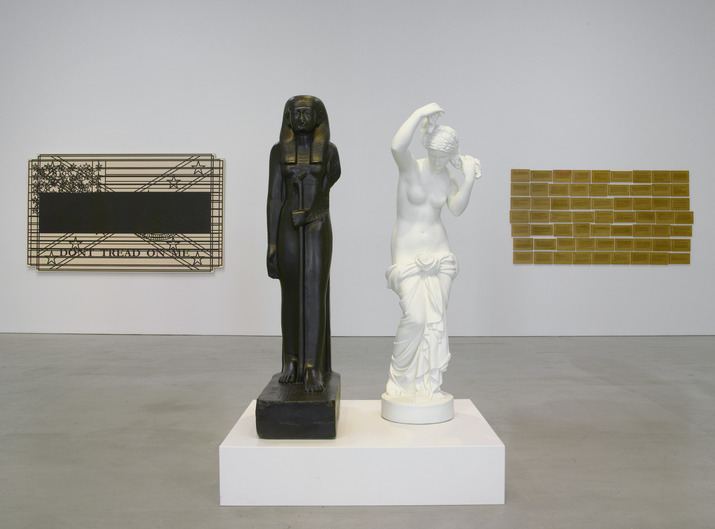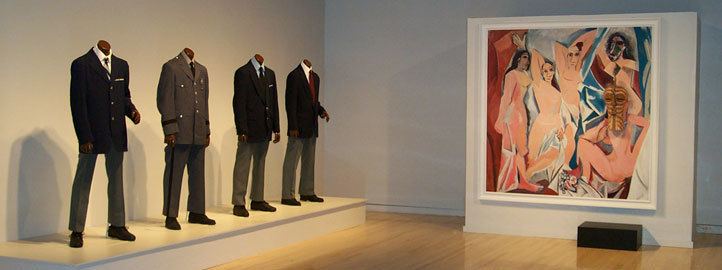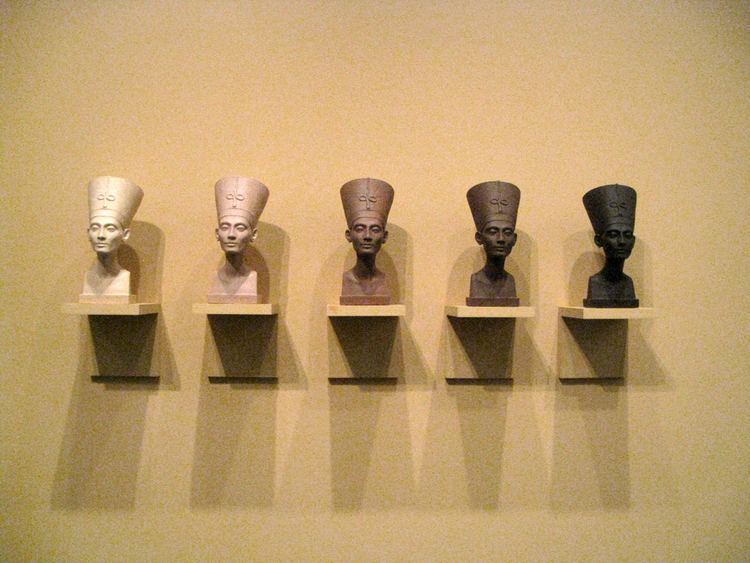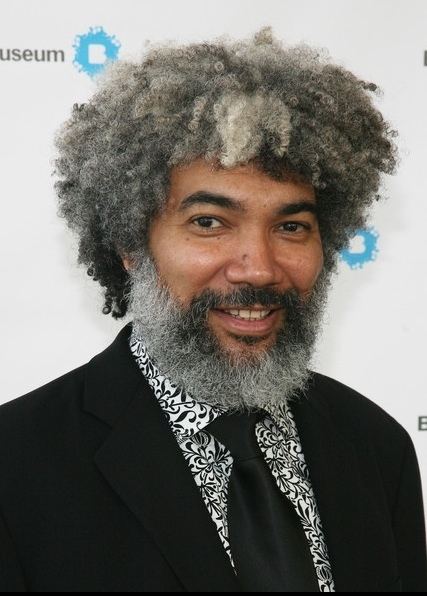Role Artist Name Fred Wilson | ||
 | ||
Education State University of New York at Purchase Books Pictures, Patents, Monkeys, and More ... on Collecting | ||
Artist fred wilson in conversation with curator in residence george ciscle
Fred Wilson (born 1954) is an American artist. He describes himself as of "African, Native American, European and Amerindian" descent. Wilson received a MacArthur Foundation "genius grant" in 1999 and the Larry Aldrich Foundation Award in 2003. Wilson represented the United States at the Biennial Cairo in 1992 and the Venice Biennale in 2003. In May 2008, it was announced that Wilson would become a Whitney Museum trustee replacing Chuck Close. Wilson is represented by The Pace Gallery in New York.
Contents
- Artist fred wilson in conversation with curator in residence george ciscle
- Meet the artist fred wilson
- Career
- Major themes
- Mining the Museum exhibition
- Selected exhibitions
- References

Meet the artist fred wilson
Career

An alumnus of Music & Art High School in New York, Wilson received a BFA from SUNY Purchase in 1976, where he was the only black student in his program. He says that he no longer has a strong desire to make things with his hands. "I get everything that satisfies my soul," he says, "from bringing together objects that are in the world, manipulating them, working with spatial arrangements, and having things presented in the way I want to see them."

An installation artist and political activist, Wilson's subject is social justice and his medium is museology. In the 1970s, he worked as a free-lance museum educator for the American Museum of Natural History, the Metropolitan Museum of Art and the American Craft Museum. Beginning in the late 1980s, Wilson used his insider skills to create "Rooms with a View", a series of "mock museums" that address how museums consciously or unwittingly reinforce racist beliefs and behaviors. This strategy, which Wilson refers to as "a trompe l'oeil of museum space," has increasingly become the focus of his life's work.

From 1988 to 1992, Wilson served on the board of directors at Artists Space in TriBeCa, New York.

In 1987, as part of his outdoor "Platform" series, Wilson created No Noa Noa, Portrait of a History of Tahiti, designed to illustrate "how Western societies turn Third World peoples into exotic sideshow creatures to entertain and titillate but who are not to be taken seriously."
In his 1992 seminal work co-organized with The Contemporary Museum, Mining the Museum, Wilson reshuffled the Maryland Historical Society's collection to highlight the history of Native and African Americans in Maryland. In 1994, Wilson continued in this vein with Insight: In Site: In Sight: Incite in Winston-Salem, North Carolina, where, according to art historian Richard J. Powell, his "re-positioning of historical objects and manipulation of exhibition labels, lighting, and other display techniques helped reveal aspects of the site's tragic African-American past that (because of the conspiratorial forces of time, ignorance, and racism) had largely become invisible."
In 2001, Wilson was the subject of a retrospective, Fred Wilson: Objects and Installations, 1979–2000, organized by Maurice Berger for the Center for Art and Visual Culture, University of Maryland, Baltimore County (UMBC), Baltimore County. The show traveled to numerous venues, including the Santa Monica Museum of Art, Berkeley Museum of Art, Blaffer Gallery (University of Houston), Tang Teaching Museum and Art Gallery (Skidmore College, Saratoga Springs, NY), The Addison Gallery of American Art in Andover, Massachusetts, Chicago Cultural Center, Studio Museum in Harlem. For the 2003 Venice Biennale, Wilson created a multi-media installation that borrowed its title from a line in Othello. His elaborate Venice work "Speak of Me as I Am" focused on representations of Africans in Venetian culture.
In 2007 Fred Wilson was invited to be a part of the Indianapolis, Indiana, Cultural trail. Wilson proposed to redo the sole African American depicted in the Soldiers and Sailors Monument in downtown Indianapolis. The African American represents a recently freed slave reaching up to lady liberty. Wilson planned on using a scan of the African American to make an entirely new work, which would give the African American a more proud and strong posture, holding a flag composed of all of the African countries' flags. The proposed work was entitled, E Pluribus Unum, and was met with much controversy, eventually leading to the project's rejection.
In 2009, Wilson was awarded the Cheek Medal by William & Mary’s Muscarelle Museum of Art. The Cheek Medal is a national arts award given by The College of William & Mary to those who have contributed significantly to the field of museum, performing or visual arts.
2011 saw the publication of Fred Wilson: A Critical Reader by Ridinghouse, edited by Doro Globus. An anthology of critical texts about and interviews with the artist, this publication focuses on the artist's pivotal exhibitions and projects, and includes a wide range of significant texts that mark the critical reception of Wilson's work over the last two decades.
Major themes
Wilson's unique artist approach is to examine, question, and deconstruct the traditional display of art and artifacts in museums. With the use of new wall labels, sounds, lighting, and non-traditional pairings of objects, he leads viewers to recognize that changes in context create changes in meaning. Wilson's juxtaposition of evocative objects forces the viewer to question the biases and limitations of cultural institutions and how they have shaped the interpretation of historical truth, artistic value, and the language of display.
For example, for his installation at the 2003 Venice Biennale he employed a tourist to pretend to be an African street vendor selling fake designer bags — in fact his own designs. He also incorporated "blackamoors", sculptures of black people in the role of servants, into the show. Such figures were often used as stands for lights. Wilson placed his wooden blackamoors carrying acetylene torches and fire extinguishers. He noted that such figures are so common in Venice that few people notice them, stating, "they are in hotels everywhere in Venice...which is great, because all of a sudden you see them everywhere. I wanted it to be visible, this whole world which sort of just blew up for me."
Mining the Museum exhibition
Mining the Museum was an exhibition created by Fred Wilson held from April 4, 1992, to February 28, 1993 at the Maryland Historical Society.
Background
The purpose of the exhibition was to address the biases museums have, often omitting or under-representing oppressed peoples and focusing on "prominent white men". Wilson took the existing museum’s collection and reshuffled them to highlight the history of African-American and Native American Marylanders. This reassembly created a new viewpoint of colonization, slavery and abolition through the use of satire and irony.
Artifacts
Wilson juxtaposed historically important artifacts with each other to address the injustices in history and the injustices of not being properly exhibited. The entrance of the exhibition displayed three busts of important individuals: Napoleon, Andrew Jackson and Henry Clay displayed on pedestals. To the left of these busts were empty black pedestals with the names of three important, overlooked African American Marylanders: Frederick Douglass, Benjamin Banneker, and Harriet Tubman.
The installation titled "metalwork" arranged ornate silverware with slave shackles to address that the prosperity of one could not have been achieved without the other. Similarly, "Cabinet Making" addresses more subjugation by having antique chairs gathered around and facing an authentic whipping post, incorrectly reported by several publications to have been used on slaves. In fact, the post had been used to punish wife-beaters in the Baltimore City jail. However, these false assumptions helped bolster Wilson's idea that the exhibit was "charged by what you bring to it." Pieces such as "Cabinet Making" encouraged visitors to interpret the works however they saw it, to think critically and acquire a new perspective. Other works included cigar-store Indians turned away from visitors, a KKK mask in a baby carriage, a hunting rifle with runaway slave posters and a black chandelier hung in the museum's neoclassical pavilion made for the exhibition.
Impact
The exhibition was successful in that it made visitors more historically conscious of the racism that is an integral part of American history. "“Mining the Museum” worked because it was suggestive rather than didactic, provocative rather than moralizing" More than 5,000 people viewed Wilson's exhibit and helped him create other similar exhibitions around the United States. Critics would coin this new type of work as "museumist art".
